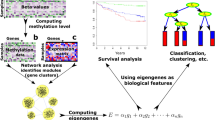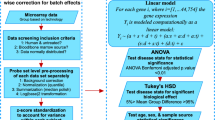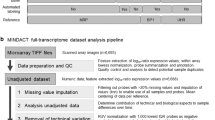Abstract
A plethora of studies have documented that gene expression profiling using DNA microarrays for various types of hematological malignancies provides novel information, which may have diagnostic and prognostic implications. However, to successfully use microarrays for this purpose, the quality and reproducibility of the whole procedure need to be guaranteed. Critical steps of the method are handling, processing and storage of the leukemic sample, purification of tumor cells (or lack thereof), RNA extraction methods, quality control of RNA, labeling techniques, hybridization, washing, scanning, spot filtering, normalization and initial interpretation, and finally the biostatistical analysis. These items have been extensively discussed and evaluated in different multi-center quality rounds within the three networks, that is, I-BFM-SG, the German Competence Network ‘Acute and Chronic Leukemias’ and the European LeukemiaNet. Based on the exchange of knowledge and experience between the three networks over the last few years, we have formulated guidelines for performing microarray experiments in leukemia. We confine ourselves to leukemias, but many of these requirements also apply to lymphomas or other clinical samples, including solid tumors.
This is a preview of subscription content, access via your institution
Access options
Subscribe to this journal
Receive 12 print issues and online access
$259.00 per year
only $21.58 per issue
Buy this article
- Purchase on Springer Link
- Instant access to full article PDF
Prices may be subject to local taxes which are calculated during checkout



Similar content being viewed by others
References
Schena M, Shalon D, Davis RW, Brown PO . Quantitative monitoring of gene expression patterns with a complementary DNA microarray. Science 1995; 270: 467–470.
Hofmann WK, de Vos S, Elashoff D, Gschaidmeier H, Hoelzer D, Koeffler HP et al. Relation between resistance of Philadelphia-chromosome-positive acute lymphoblastic leukaemia to the tyrosine kinase inhibitor STI571 and gene-expression profiles: a gene-expression study. Lancet 2002; 359: 481–486.
Debernardi S, Lillington DM, Chaplin T, Tomlinson S, Amess J, Rohatiner A et al. Genome-wide analysis of acute myeloid leukemia with normal karyotype reveals a unique pattern of homeobox gene expression distinct from those with translocation-mediated fusion events. Genes Chromosomes Cancer 2003; 37: 149–158.
Schoch C, Kohlmann A, Schnittger S, Brors B, Dugas M, Mergenthaler S et al. Acute myeloid leukemias with reciprocal rearrangements can be distinguished by specific gene expression profiles. Proc Natl Acad Sci USA 2002; 99: 10008–10013.
Kohlmann A, Schoch C, Schnittger S, Dugas M, Hiddemann W, Kern W et al. Molecular characterization of acute leukemias by use of microarray technology. Genes Chromosomes Cancer 2003; 37: 396–405.
Haferlach T, Kohlmann A, Kern W, Hiddemann W, Schnittger S, Schoch C . Gene expression profiling as a tool for the diagnosis of acute leukemias. Semin Hematol 2003; 40: 281–295.
Kohlmann A, Schoch C, Schnittger S, Dugas M, Hiddemann W, Kern W et al. Pediatric acute lymphoblastic leukemia (ALL) gene expression signatures classify an independent cohort of adult ALL patients. Leukemia 2004; 18: 63–71.
Bullinger L, Dohner K, Bair E, Frohling S, Schlenk RF, Tibshirani R et al. Use of gene-expression profiling to identify prognostic subclasses in adult acute myeloid leukemia. N Engl J Med 2004; 350: 1605–1616.
Pellagatti A, Esoof N, Watkins F, Langford CF, Vetrie D, Campbell LJ et al. Gene expression profiling in the myelodysplastic syndromes using cDNA microarray technology. Br J Haematol 2004; 125: 576–583.
Haslinger C, Schweifer N, Stilgenbauer S, Dohner H, Lichter P, Kraut N et al. Microarray gene expression profiling of B-cell chronic lymphocytic leukemia subgroups defined by genomic aberrations and VH mutation status. J Clin Oncol 2004; 22: 3937–3949.
Stam RW, den Boer ML, Meijerink JP, Ebus ME, Peters GJ, Noordhuis P et al. Differential mRNA expression of Ara-C-metabolizing enzymes explains Ara-C sensitivity in MLL gene-rearranged infant acute lymphoblastic leukemia. Blood 2003; 101: 1270–1276.
Staal FJ, van der BM, Wessels LF, Barendregt BH, Baert MR, van den Burg CM et al. DNA microarrays for comparison of gene expression profiles between diagnosis and relapse in precursor-B acute lymphoblastic leukemia: choice of technique and purification influence the identification of potential diagnostic markers. Leukemia 2003; 17: 1324–1332.
Takagaki K, Katsuma S, Horio T, Kaminishi Y, Hada Y, Tanaka T et al. cDNA microarray analysis of altered gene expression in Ara-C-treated leukemia cells. Biochem Biophys Res Commun 2003; 309: 351–358.
Oshima Y, Ueda M, Yamashita Y, Choi YL, Ota J, Ueno S et al. DNA microarray analysis of hematopoietic stem cell-like fractions from individuals with the M2 subtype of acute myeloid leukemia. Leukemia 2003; 17: 1990–1997.
van Delft FW, Jones LK . Oligonucleotide microarray analysis of gene expression in leukemia. Method Mol Med 2004; 91: 183–196.
Ross ME, Mahfouz R, Onciu M, Liu HC, Zhou X, Song G et al. Gene expression profiling of pediatric acute myelogenous leukemia. Blood 2004; 104: 3679–3687.
Mano H . Stratification of acute myeloid leukemia based on gene expression profiles. Int J Hematol 2004; 80: 389–394.
Cario G, Stanulla M, Fine BM, Teuffel O, Neuhoff NV, Schrauder A et al. Distinct gene expression profiles determine molecular treatment response in childhood acute lymphoblastic leukemia. Blood 2005; 105: 821–826.
Lipshutz RJ, Fodor SP, Gingeras TR, Lockhart DJ . High density synthetic oligonucleotide arrays. Nat Genet 1999; 21 (Suppl 1): 20–24.
Pollack JR, Perou CM, Alizadeh AA, Eisen MB, Pergamenschikov A, Williams CF et al. Genome-wide analysis of DNA copy-number changes using cDNA microarrays. Nat Genet 1999; 23: 41–46.
Golub TR, Slonim DK, Tamayo P, Huard C, Gaasenbeek M, Mesirov JP et al. Molecular classification of cancer: class discovery and class prediction by gene expression monitoring. Science 1999; 286: 531–537.
Alizadeh AA, Eisen MB, Davis RE, Ma C, Lossos IS, Rosenwald A et al. Distinct types of diffuse large B-cell lymphoma identified by gene expression profiling. Nature 2000; 403: 503–511.
Armstrong SA, Staunton JE, Silverman LB, Pieters R, den Boer ML, Minden MD et al. MLL translocations specify a distinct gene expression profile that distinguishes a unique leukemia. Nat Genet 2002; 30: 41–47.
Ferrando AA, Neuberg DS, Staunton J, Loh ML, Huard C, Raimondi SC et al. Gene expression signatures define novel oncogenic pathways in T cell acute lymphoblastic leukemia. Cancer Cell 2002; 1: 75–87.
Yeoh EJ, Ross ME, Shurtleff SA, Williams WK, Patel D, Mahfouz R et al. Classification, subtype discovery, and prediction of outcome in pediatric acute lymphoblastic leukemia by gene expression profiling. Cancer Cell 2002; 1: 133–143.
Olshen AB, Jain AN . Deriving quantitative conclusions from microarray expression data. Bioinformatics 2002; 18: 961–970.
De Pitta C, Tombolan L, Campo Dell'Orto M, Accordi B, te Kronnie G, Romualdi C et al. A leukemia-enriched cDNA microarray platform identifies new transcripts with relevance to the biology of pediatric acute lymphoblastic leukemia. Haematologica 2005; 90: 890–898.
Schena M, Heller RA, Theriault TP, Konrad K, Lachenmeier E, Davis RW . Microarrays: biotechnology's discovery platform for functional genomics. Trends Biotechnol 1998; 16: 301–306.
Hardiman G . Microarray platforms – comparisons and contrasts. Pharmacogenomics 2004; 5: 487–502.
Stoughton RB . Applications of DNA microarrays in biology. Annu Rev Biochem 2005; 74: 53–82.
Mockler TC, Ecker JR . Applications of DNA tiling arrays for whole-genome analysis. Genomics 2005; 85: 1–15.
Shih I, Wang TL . Apply innovative technologies to explore cancer genome. Curr Opin Oncol 2005; 17: 33–38.
Larkin JE, Frank BC, Gavras H, Sultana R, Quackenbush J . Independence and reproducibility across microarray platforms. Nat Method 2005; 2: 337–344.
Expression profiling – best practices for data generation and interpretation in clinical trials. Nat Rev Genet 2004; 5: 229–237.
Brazma A, Hingamp P, Quackenbush J, Sherlock G, Spellman P, Stoeckert C et al. Minimum information about a microarray experiment (MIAME) – toward standards for microarray data. Nat Genet 2001; 29: 365–371.
Brazma A, Parkinson H, Sarkans U, Shojatalab M, Vilo J, Abeygunawardena N et al. ArrayExpress – a public repository for microarray gene expression data at the EBI. Nucleic Acids Res 2003; 31: 68–71.
Marshall E . Getting the noise out of gene arrays. Science 2004; 306: 630–631.
Michiels S, Koscielny S, Hill C . Prediction of cancer outcome with microarrays: a multiple random validation strategy. Lancet 2005; 365: 488–492.
Irizarry RA, Warren D, Spencer F, Kim IF, Biswal S, Frank BC et al. Multiple-laboratory comparison of microarray platforms. Nat Method 2005; 2: 345–350.
Kohlmann A, Schoch C, Dugas M, Rauhut S, Weninger F, Schnittger S et al. Pattern robustness of diagnostic gene expression signatures in leukemia. Genes Chromosomes Cancer 2005; 42: 299–307.
Breit S, Nees M, Schaefer U, Pfoersich M, Hagemeier C, Muckenthaler M et al. Impact of pre-analytical handling on bone marrow mRNA gene expression. Br J Haematol 2004; 126: 231–243.
Brunialti MK, Kallas EG, Freudenberg M, Galanos C, Salomao R . Influence of EDTA and heparin on lipopolysaccharide binding and cell activation, evaluated at single-cell level in whole blood. Cytometry 2002; 50: 14–18.
Nicholson JK, Green TA . Selection of anticoagulants for lymphocyte immunophenotyping. Effect of specimen age on results. J Immunol Methods 1993; 165: 31–35.
Wu K, Miyada G, Martin J, Finkelstein D, Palma J, Pillai R et al. Globin reduction protocol. In Affymetrix Technical Note, WWW document. Available at http://www.Affymetrix.com/support/technical/technotes/blood2_technote.
de Ridder D, van der Linden CE, Schonewille T, Dik WA, Reinders MJ, van Dongen JJ et al. Purity for clarity: the need for purification of tumor cells in DNA microarray studies. Leukemia 2005; 19: 618–627.
Dave SS, Wright G, Tan B, Rosenwald A, Gascoyne RD, Chan WC et al. Prediction of survival in follicular lymphoma based on molecular features of tumor-infiltrating immune cells. N Engl J Med 2004; 351: 2159–2169.
Wilfinger WW, Mackey K, Chomczynski P . Effect of pH and ionic strength on the spectrophotometric assessment of nucleic acid purity. Biotechniques 1997; 22: 474–481.
Imbeaud S, Graudens E, Boulanger V, Barlet X, Zaborski P, Eveno E et al. Towards standardization of RNA quality assessment using user-independent classifiers of microcapillary electrophoresis traces. Nucleic Acids Res 2005; 33: e56.
Auer H, Lyianarachchi S, Newsom D, Klisovic MI, Marcucci G, Kornacker K . Chipping away at the chip bias: RNA degradation in microarray analysis. Nat Genet 2003; 35: 292–293.
Van Gelder RN, von Zastrow ME, Yool A, Dement WC, Barchas JD, Eberwine JH . Amplified RNA synthesized from limited quantities of heterogeneous cDNA. Proc Natl Acad Sci USA 1990; 87: 1663–1667.
Fine BM, Stanulla M, Schrappe M, Ho M, Viehmann S, Harbott J et al. Gene expression patterns associated with recurrent chromosomal translocations in acute lymphoblastic leukemia. Blood 2004; 103: 1043–1049.
RNA Controls Consortium, Reid L. Proposed methods for testing and selecting the ERCC external RNA controls. BMC Genom 2005; 6: 150.
Tusher VG, Tibshirani R, Chu G . Significance analysis of microarrays applied to the ionizing radiation response. Proc Natl Acad Sci USA 2001; 98: 5116–5121.
Pan W . A comparative review of statistical methods for discovering differentially expressed genes in replicated microarray experiments. Bioinformatics 2002; 18: 546–554.
Quackenbush J . Computational analysis of microarray data. Nat Rev Genet 2001; 2: 418–427.
Allison DB, Cui X, Page GP, Sabripour M . Microarray data analysis: from disarray to consolidation and consensus. Nat Rev Genet 2006; 7: 55–65.
Staege MS, Hansen G, Baersch G, Burdach S . Functional and molecular characterization of interleukin-2 transgenic Ewing tumor cells for in vivo immunotherapy. Pediatr Blood Cancer 2004; 43: 23–34.
Storey H . A direct approach to false discovery rates. J R Statist Soc Ser B 2002; 64 (Part 3): 479–498.
Acknowledgements
The excellent technical assistance of Marcel Tauscher in performing the multi-center quality rounds is gratefully acknowledged. Dick de Ridder is acknowledged for his expert opinion on bioinformatical software packages. The activities of the Genomics/Proteomics project of the German Competence Network ‘Acute and Chronic Leukemias’ have been supported by BMBF Grant 01GI0378.
Author information
Authors and Affiliations
Corresponding author
Appendix A
Appendix A
I-BFM-SG Task Force on gene expression profiling: G Cario, Kiel (DE); G Cazzaniga, Monza (IT); J Cloos, Amsterdam (NL); M den Boer, Rotterdam (NL); A Hall, Newcastle (UK); J Harbott, Giessen (DE); J Irving, Newcastle (UK); S Izraeli, Tel Aviv (IL); F Niggli, Zurich (CH); U Ozbek, Istanbul (TR); B Schaefer, Zurich (CH); FJT Staal, Rotterdam (NL); MS Staege, Halle (DE); M Stanulla, Hannover (DE); G te Kronnie, Padua (IT); O Teuffel, Zurich (CH); F van Delft, London (UK); JJM van Dongen, Rotterdam (NL); M Zwaan, Amsterdam (NL). Genomics/ Proteomics group of the German Competence Network ‘Acute and Chronic Leukemias’: S Balabanov, Tübingen; TH Brümmendorf, Tübingen; L Bullinger, Ulm; H Döhner, Ulm; J Duyster, München; R Eils, Heidelberg; O Frank, Mannheim; T Haferlach, München; R Hehlmann, Mannheim; M Heuser, Hannover; A Hochhaus, Mannheim; W-K Hofmann, Berlin/Frankfurt; P Lichter, Heidelberg; A Neubauer, Marburg; M Ritter, Marburg; B Schlegelberger, Hannover; C Schoch, München; W Seifarth, Mannheim; M Tauscher, Hannover; C Thiede, Dresden; N von Bubnoff, München; LU Wingen, Hannover; C Zheng, Mannheim. WP13 Gene Profiling of European LeukemiaNet: T Haferlach, Munich (DE); G Basso, Padova (IT); MC Bené, Nancy (FR); L Bullinger, Ulm (DE); S Chiaretti, Rome (IT); H Döhner, Ulm (DE); M Dugas, Munich (DE); S Ferrari, Modena (IT); R Foa, Rome (IT); JM Hernandez Rivas, Salamanca (ES); W-K Hofmann, Berlin (DE); JH Jansen, Nijmegen (NL); A Kohlmann, Munich (DE); G te Kronnie, Padua (IT); E Macintyre, Paris (FR); JV Melo, London (UK); K Mills, Cardiff (UK); A Neubauer, Marburg (DE); C Preudhomme, Lille (FR); B Schlegelberger, Hannover (DE); W Seifarth, Mannheim (DE); J de Vos, Montpellier (FR); BD Young, London (UK).
Rights and permissions
About this article
Cite this article
Staal, F., Cario, G., Cazzaniga, G. et al. Consensus guidelines for microarray gene expression analyses in leukemia from three European leukemia networks. Leukemia 20, 1385–1392 (2006). https://doi.org/10.1038/sj.leu.2404274
Received:
Revised:
Accepted:
Published:
Issue Date:
DOI: https://doi.org/10.1038/sj.leu.2404274
Keywords
This article is cited by
-
Entstehung, Entwicklung und Erfolge des Kompetenznetzes Akute und Chronische Leukämien (KNL)
Bundesgesundheitsblatt - Gesundheitsforschung - Gesundheitsschutz (2016)
-
Deregulated WNT signaling in childhood T-cell acute lymphoblastic leukemia
Blood Cancer Journal (2014)
-
Long-term results of five consecutive trials in childhood acute lymphoblastic leukemia performed by the ALL-BFM study group from 1981 to 2000
Leukemia (2010)
-
Genome-wide expression analysis of paired diagnosis–relapse samples in ALL indicates involvement of pathways related to DNA replication, cell cycle and DNA repair, independent of immune phenotype
Leukemia (2010)
-
Quality control in microarray assessment of gene expression in human airway epithelium
BMC Genomics (2009)



